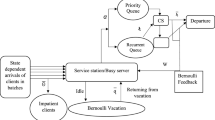Abstract
The paper presents the results of the study aimed at determining the optimal number of workers, who are employed in equipment-specific production, through the use of the queueing theory. The relevance of the research is that service operations in equipment-specific processes are performed irregularly and at any time, there may be equipment and workspaces downtime in expectation of the service activities. Moreover, there may be deadtime in operational people’s activities in wait for the service requests. Therefore, there is a need to determine service standards that would ensure both a minimum of the total costs in the personnel expenses and possible losses from equipment downtime. This task is complex and multi-variant, and it requires the use of mathematical methods. The authors presented the methodology for the queueing theory usage to develop efficient size standards in terms of alloy melting processes in gas-fired reverberatory furnaces, and calculation data of the service system performance indicators for melting furnaces by a working team of various size.
Access this chapter
Tax calculation will be finalised at checkout
Purchases are for personal use only
Similar content being viewed by others
References
Afolalu, S.A., Babaremu, K.O., Ongbali, S.O., Abdulkareem, A., Adejuyigbe, S.B.: Overview impact of application of queuing theory model on productivity performance in a banking sector. J. Phys: Conf. Ser. 1378(3), 032033 (2019)
Delasay, M., Ingolfsson, A., Kolfal, B., Schultz, K.: Load effect on service times. Eur. J. Oper. Res. 279(3), 673–686 (2019)
Dodonov, V.V.: Application of the queueing theory elements to analyze productivity and reliability of automated machine. High. Educ. News 12, 70–76 (2011)
Fazlollahtabar, H., Gholizadeh, H.: Application of queuing theory in quality control of multi-stage flexible flow shop. Yugoslav J. Oper. Res. 30(1), 101–108 (2020)
Gazizova, L.R., Galimulina, F.F.: Mass service system in private medicine. Sustain. Dev. Manag. 6(19), 5–10 (2018)
Irani, S.A., Chrissis, J.W.: Applications of queueing structures in manufacturing systems. Comput. Ind. Eng. 11(1–4), 215–219 (1986)
Ivanov, A.A.: Object modeling of the automated production based on the theory of mass service. Proc. Nizhny Novgorod Tech. Univ. R.E. Alekseeva 1(98), 88–93 (2013)
Li, C., Sun, C., Zhang, J.: The staffing optimization problem for the m-design multi-skill call center based on queuing model. In: Wang, R., Chen, Z., Zhang, W., Zhu, Q. (eds.) Proceedings of the 11th International Conference on Modelling, Identification and Control. Lecture Notes in Electrical Engineering, vol. 582, pp. 585–595. Springer, Cham (2020). https://doi.org/10.1007/978-981-15-0474-7_55
Nosov, M.A., Sabinina, A.L., Antseva, N.V.: Optimization of the maintenance crews quantitative composition in the quality management of industrial enterprises equipment maintenance. Notes of the Tula State University. Tech. Sci. 11(2), 202–208 (2016)
Wen, J., Geng, N., Xie, X.: Real-time scheduling of semi-urgent patients under waiting time targets. Int. J. Prod. Res. 58(4), 1127–1143 (2020)
Author information
Authors and Affiliations
Corresponding author
Editor information
Editors and Affiliations
Rights and permissions
Copyright information
© 2021 The Editor(s) (if applicable) and The Author(s), under exclusive license to Springer Nature Switzerland AG
About this paper
Cite this paper
Bogatyreva, I.V., Ilyukhina, L.A., Makhmudova, I.N., Kozhukhova, N.V. (2021). Queueing Theory: New Solutions to Optimize the Number of Workers. In: Ashmarina, S.I., Mantulenko, V.V. (eds) Digital Economy and the New Labor Market: Jobs, Competences and Innovative HR Technologies. IPM 2020. Lecture Notes in Networks and Systems, vol 161. Springer, Cham. https://doi.org/10.1007/978-3-030-60926-9_53
Download citation
DOI: https://doi.org/10.1007/978-3-030-60926-9_53
Published:
Publisher Name: Springer, Cham
Print ISBN: 978-3-030-60925-2
Online ISBN: 978-3-030-60926-9
eBook Packages: EngineeringEngineering (R0)




